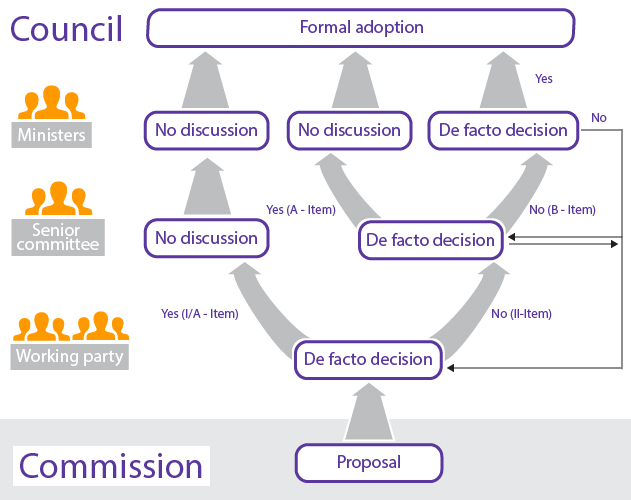The legislative function of the Council
Now you probably want to know how the Council makes decisions and how it adopts new laws. Let’s look at the ordinary legislative procedure, the procedure that is most widely used.
The decision-making process begins with the European Commission sending the proposal for a new law, after it has been approved by the College of Commissioners. The working parties of the Council of Ministers receive the proposal and identify points of agreement and disagreement (agreement listed as I; disagreement and further discussion as II). Then they send the proposal to COREPER. COREPER looks at the proposal and tries to reach agreements on the remaining problems. It divides points into two categories: A items (agreement reached), B items (disagreement). The agreed A items are sent to relevant Councils. The Councils look at the proposal and decide whether to approve it or not and very often they agree without voting (McCormick, 2011 B, p. 194). When a vote is needed however, Qualified Majority Voting is used in most cases.
The number of voices given to each Member State is specified by the Treaty. You can use the voting calculator to see which countries have the most votes.
Once the decision has been reached by the Council, the proposal goes to the European Parliament. The Parliament and the Council might pass it back and forth – with amendments – up to twice. If no agreement is reached, the proposal goes to the meeting of the Conciliation Committee, made up of representatives of the Council and the Parliament and attended by the representatives of the Commission, who amend the proposal until they reach an agreement. The proposal is sent to the Council and the Parliament for the final reading and vote. They can adopt it as a legislative law or reject it.
See the diagram below to better understand the internal decision making process of the Council:

Internal decision making process of the Council.
Key points to remember
- The Council is a decision-making institution.
- The Council together with the European Parliament exercises legislative and budgetary functions.
- Meetings of the Council bring together relevant ministers who represent their Member State.
- There are 10 different council configurations, but the Council of Ministers is just one institution.
- The configuration of the Council depends on the issue under discussion. The General Affairs Council meets to discuss issues that affect more than one policy area.
- The Council is chaired by a minister from the country holding presidency, except for a meeting of Foreign Affairs ministers, chaired by the High Representative of the Union for Foreign and Security Policy.
Calendar
| M | T | W | T | F | S | S |
|---|---|---|---|---|---|---|
| 1 | 2 | 3 | 4 | 5 | 6 | 7 |
| 8 | 9 | 10 | 11 | 12 | 13 | 14 |
| 15 | 16 | 17 | 18 | 19 | 20 | 21 |
| 22 | 23 | 24 | 25 | 26 | 27 | 28 |
| 29 | 30 | 31 | ||||
Leave a Reply